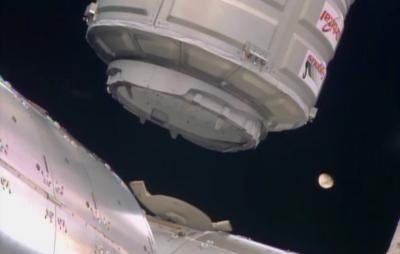Thu, Dec 10, 2015
Fifty-Day Stay Planned At Station
The “S.S. Deke Slayton II” Cygnus spacecraft successfully completed its rendezvous and berthing procedures with the International Space Station (ISS) Wednesday morning. This is the company’s fourth successful berthing with the orbiting laboratory, and the third under NASA’s Commercial Resupply Services (CRS) contract.

Cygnus was launched aboard a United Launch Alliance (ULA) Atlas V rocket on December 6, from Cape Canaveral Air Force Station, Florida. Over the past several days, it completed a series of thruster firings and other maneuvers bringing the spacecraft in close proximity to the ISS. Final approach to the Station began at about 5:00 a.m. (EST), culminating with Expedition 45 crew members grappling Cygnus with the Station’s robotic arm at 6:19 a.m. when it was approximately 30 feet from the ISS. Cygnus was then guided to its berthing port on the nadir side of the Unity module of the ISS where its installation was completed at 9:26 a.m. (EST).
“This mission featured the debut of our enhanced Cygnus, which allowed us to transport approximately 7,700 pounds of essential supplies, equipment and scientific experiments to the astronauts on board the ISS,” said Frank Culbertson, President of Orbital ATK’s Space Systems Group. “That represents a more than 50 percent increase in capacity over the previous Cygnus model. This expanded cargo capability, along with Cygnus’ new UltraFlex solar array and fuel tank enhancements, allows us to deliver greater value to our NASA customer.”
The Expedition 45 crew plans to open the Cygnus hatch and make initial ingress into its cargo module tomorrow to unload the cargo, including food, clothing, crew supplies, spare parts, laboratory equipment and scientific experiments. Cygnus will remain berthed at the ISS for approximately 50 days before departing with approximately 5,050 pounds of disposable cargo for a safe, destructive reentry over the Pacific Ocean.
Under the CRS contract with NASA, Orbital ATK will deliver approximately 62,000 pounds of cargo to the ISS over 10 missions through 2018. To date, the company has delivered more than seven tons of essential supplies to the ISS since the first mission conducted in early 2014, with three additional CRS missions scheduled for 2016. Another Cygnus mission will be launched on an Atlas V in March, after which Orbital ATK’s Antares rocket will launch at least two ISS resupply missions in the second and fourth quarters of 2016.
(Source: Orbital ATK news release.File image from previous mission)
More News
The Industry Continues to be Rocked By Some Questionable Operations Recent investigations and a great deal of data has resulted in ANN’s SportPlane Resource Guide’s rep>[...]
Make Sure You NEVER Miss A New Story From Aero-News Network Do you ever feel like you never see posts from a certain person or page on Facebook or Instagram? Here’s how you c>[...]
Visual Approach Slope Indicator (VASI) An airport lighting facility providing vertical visual approach slope guidance to aircraft during approach to landing by radiating a directio>[...]
Airport Marking Aids Markings used on runway and taxiway surfaces to identify a specific runway, a runway threshold, a centerline, a hold line, etc. A runway should be marked in ac>[...]
Aero Linx: The Skyhawk Association The Skyhawk Association is a non-profit organization founded by former Skyhawk Pilots which is open to anyone with an affinity for the A-4 Skyhaw>[...]
 Unfortunate... ANN/SportPlane Resource Guide Adds To Cautionary Advisories
Unfortunate... ANN/SportPlane Resource Guide Adds To Cautionary Advisories ANN FAQ: Turn On Post Notifications
ANN FAQ: Turn On Post Notifications ANN's Daily Aero-Term (04.29.24): Visual Approach Slope Indicator (VASI)
ANN's Daily Aero-Term (04.29.24): Visual Approach Slope Indicator (VASI) ANN's Daily Aero-Term (04.28.24): Airport Marking Aids
ANN's Daily Aero-Term (04.28.24): Airport Marking Aids ANN's Daily Aero-Linx (04.28.24)
ANN's Daily Aero-Linx (04.28.24)



